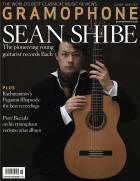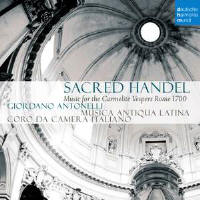Texte paru dans: / Appeared in: |
|
|
Outil de traduction (Très approximatif) |
|
|
Reviewer:
David Vickers This problematically titled album explores numerous composers who participated in the annual feast of the Madonna del Carmine (July 16) celebrated at S Maria di Montesanto in Rome during the 1690s and early 1700s. Luca della Libera’s scholarly note reports evidence found in the Vatican archives that the Carmelite Vespers celebrations featured music-making by Corelli and his orchestra, the Bolognese Colonna, his pupils the Bononcini brothers, and Alessandro Scarlatti. A broad picture of the sorts of things that might have been used in a complete Carmelite liturgy (although not on any single occasion) is compiled using chants taken from different suitable sources and performed in different ways, a few different bells tolling, and numerous short pieces by Kerll, Pasquini and Frescobaldi played solemnly by organist Salvatore Carchiolo. Handel wrote five pieces for the Carmelites’ Vespers services in 1707 and possibly 1708 (two psalms, a soprano solo motet and two alto solo antiphons). Both brief antiphons are included here; the psalms and motet are not. Deutsche Harmonia Mundi perpetuates the annoying myth that Dixit Dominus was composed for the Carmelites (it was finished in early April 1707 for an unknown occasion). Giordano Antonelli’s desire to include it is more comprehensible than why he replaced its second and third movements with Gregorian plainchants. The 13-strong Coro da Camera Italiano sing with admirably shaded rhythmical inflections that are let down sometimes by inconsistent tuning. The strings of Musica Antiqua Latina convey characterful musical ideas despite sporadic technical infelicities. Antonelli’s quick pacing and shaping spring a few surprises, such as a rapidly dextrous ‘Conquassabit’, and the soprano duo, quiet pulsing strings and men’s unison intonations in ‘De torrente’ are balanced meticulously. Recorded in the authentic reverberance of S Maria di Montesanto, the collective ensemble’s flaws are exposed uncomfortably in Colonna’s Domine ad adjuvandum and concise Lauda Jerusalem (both 1694). However, the stile antico ‘Amen’ conclusion to Alessandro Scarlatti’s short minor-key Nisi Dominus (c1721-72) brings out the best from the choir. Antonio Maria Bononcini’s Laudate pueri (1693) interweaves Adriano Ancarani’s murmuring cello obbligato with countertenor Antonello Dorigo’s sensitivity; he is less steady in Handel’s Haec est regina virginum but sings Te decus virgineum with warm poetic eloquence (and unison violins play rhetorical figures with finesse). A sung Magnificat is substituted with a Frescobaldi organ toccata, and two movements from Corelli’s Op 6 No 6 played with effective chiaroscuro form the postlude. |
|




